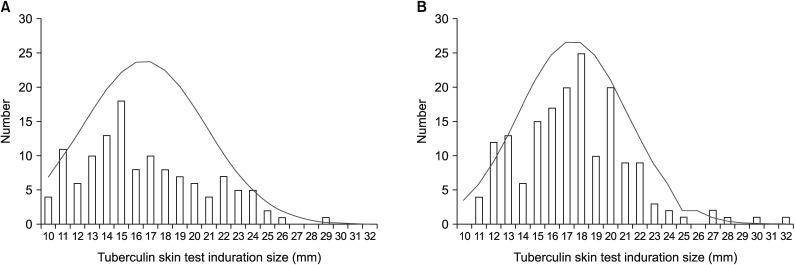 |
 |
| Tuberc Respir Dis > Volume 82(4); 2019 > Article |
|
Abstract
Background
Methods
Results
Notes
Authors' Contributions:
Conceptualization: Kim HJ (for Hee Jin Kim), Lee SH.
Methodology: Cha JH, Kim HJ (for Hee Jin Kim), Lee SH.
Formal analysis: Kim BK, Cha JH, Kim CY, Kim Y, Lee SH.
Investigation: Kim HJ (for Hee Jin Kim), Kim HJ (for Ho Jin Kim), Lee JB, Jeon J, Lee SH.
Writting - original draft preparation: Kim BK, Kim HJ (for Ho Jin Kim), Kim HJ (for Hee Jin Kim), Lee SH.
Writing - review and editing: Kim BK, Kim HJ (for Hee Jin Kim), Kim Y, Kim JH, Shin C, Lee SH.
Approval of final manuscript: all authors.
References
Figure 1
The distribution of tuberculosis skin test positive reactors (induration≥10 mm). (A) South Korean contacts. (B) North Korean refugees.

Table 1
Clinical characteristics of tuberculin skin test reactors (≥10 mm) who underwent latent tuberculosis screening
Values are presented as number (%), mean±standard deviation, or n/N (%).
*BCG scars were examined in 166 subjects among 172 NKR. †TB close contact history to an index case existed in SKC in closed correctional facility. ‡TB close contact history to a member of family existed in NKR.
SKC: South Koreans Contacts; NKR: North Koreans Refugees; BCG: bacillus Calmette-Guérin; TB: tuberculosis; BMI: body mass index; TST: tuberculin skin test; QFT-GIT: QuantiFERON-TB Gold In Tube; LTBI: latent tuberculosis infection; 4R: 4 months of treatment with rifampicin; 9H: 9 months of treatment with isoniazid; NA: not applicable.
- TOOLS
-
METRICS

- Related articles
-
Treatment of Drug-Resistant Tuberculosis -A Statement by the Committee on Therapy-
Thoracic Surgery in Tuberculosis A Statement of the Subcommittee on Surgery
Tuberculosis Treatment Defaulter Survey on Koje Island1972 December;19(4)
The Virulence of M. tuberculosis Isolated in Korea, 19681970 December;17(4)
Treatment of Tuberculosis Patients in the Private Sector in Korea.2004 May;56(5)



 PDF Links
PDF Links PubReader
PubReader Full text via DOI
Full text via DOI Print
Print Download Citation
Download Citation



